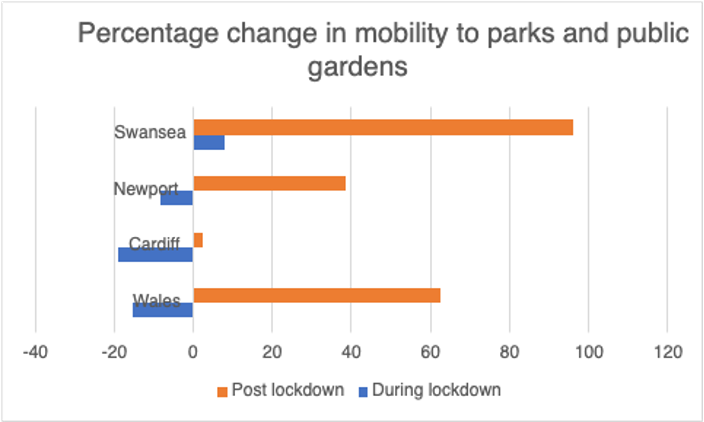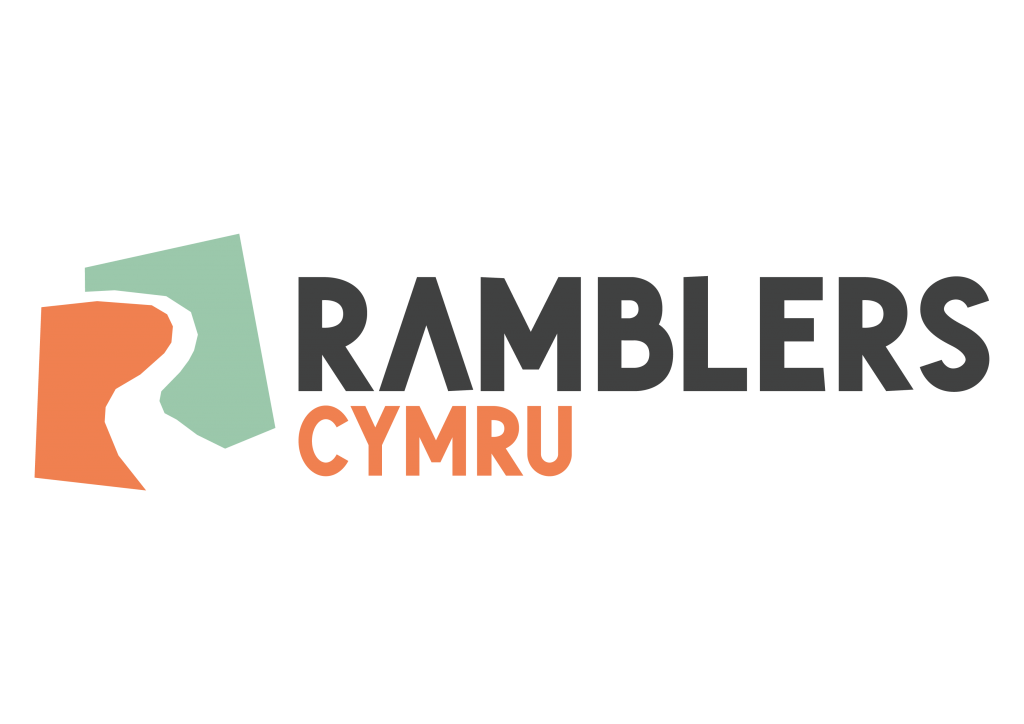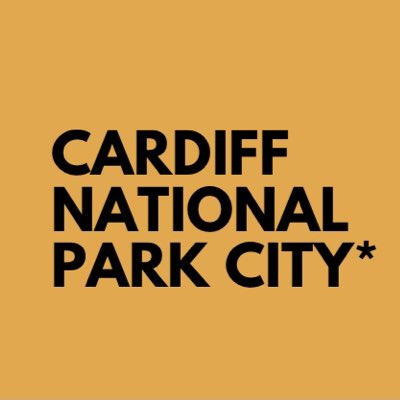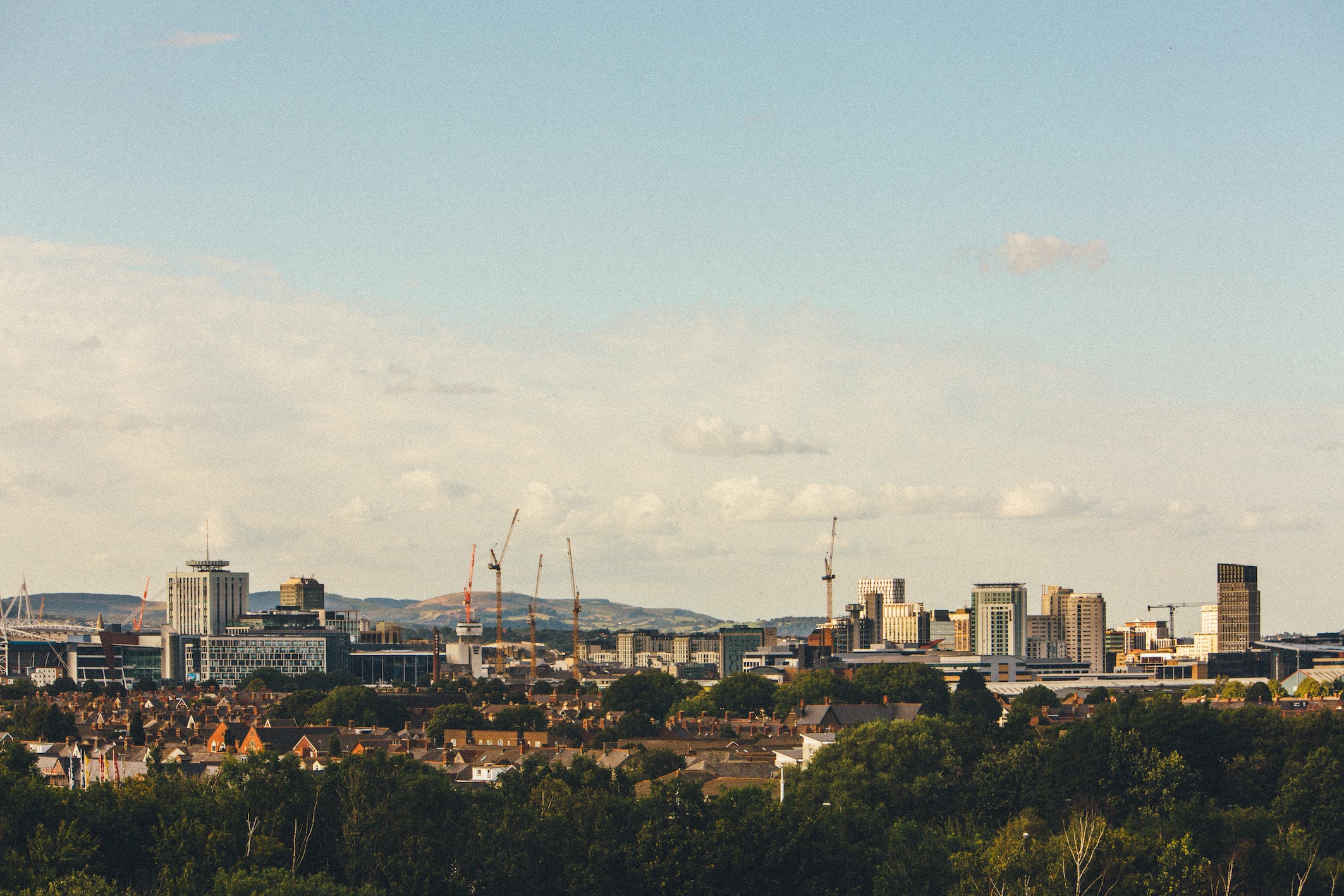How can attitudes towards and access to green space be changed?
IT has been two and a half years since the fateful day when Boris Johnson declared his firm message: ‘You must stay at home.’
It’s hard to recall how we felt that day, not knowing what the future would hold, and for how long we would be isolated.
Those lucky enough to have them spent times in gardens, or their permitted daily hour of exercise in nearby green spaces. But many did not have such luxury.
Today, when much of the ‘stay local, support local’ sentiment has dissipated, and the community feel of lockdown has faded, has people’s relationship with and access to green spaces in Cardiff changed?
The lockdown effect
The ONS used Google Maps data recorded during and post-lockdown to evaluate mobility to parks and public gardens across the UK.
⬇What is mobility data?⬇
Mobility data shows the number of visits to and time spent in public green spaces.

During lockdown, Cardiff exhibited the greatest change in mobility to parks, with a 19% decrease. It also showed the smallest increase post-lockdown, at just 3%.
The during-lockdown decrease shows that people in Cardiff spend more time in their green spaces, so when access was restricted, the decrease was more visible than in other cities.
But Swansea, a comparable city in terms of size, had a 96% increase in mobility to parks post-lockdown, showing that people spent more time in and visited public green spaces much more frequently after lockdown ended.
There was an overall increase in mobility to public green spaces in Wales, at 63% more than the baseline.
John Briggs, Landscape Adviser at Natural Resources Wales, said: “The increase in mobility to public green spaces is a positive sign. However, more evenly distributed increases would be preferable, as so-called ‘honeypot’ sites can become overrun with visitors.”
How does Cardiff fare on access to green space?
Wales trails behind the British national average, both on mean and median distance to parks or public gardens.
But Cardiff is an exception. Of all the local authorities in Wales, Cardiff has the shortest mean distance to a park or public garden, at almost 100 metres nearer than the next shortest in Vale of Glamorgan.
According to ONS data, the median distance to a green space in Cardiff is shorter than Swansea and Newport, and almost half as far as the median distance for Wales as a whole.
Fields in Trust, an independent charity, found that 19% of Cardiff is publicly accessible green space. While public access to green spaces is relatively good in Cardiff, private access is more complicated.

Only 57% of flats in Cardiff have gardens, meaning that residents would have to walk a median distance of over 350 metres to the nearest park or public garden to access green space during the pandemic.
This is lower than the national average in Wales of 64%, and during a time when only one hour of outdoor exercise was permitted per day, this meant some spent very little time in green space.
What are the benefits of access to nature?
The benefits of access to nature are manifold, as Dr Ella Furness, an Interdisciplinary Research Associate at Cardiff University’s Sustainable Places Institute explains.
She said: “There is a philosophical root to the idea that people who love nature will project nature, called biophilia.
“The theory is that if people are familiar with and comfortable with nature, they form an emotional connection with nature.
“If they feel themselves part of and belonging to nature then they will protect nature and act on behalf of it.
“This is important in a biodiversity and climate crisis, as it means people care not just about how it effects humans but all organisms and the earth itself, which is vital for our human ability to co-exist with other species.”
“The research that I have done has shown that how people connect to nature affects whether they support policy that protects the environment.”
The green-blue space project, a collaboration between several universities, has brought together experts in health, geography and data to further investigate the health benefits of access to nature.
⬇What is green-blue space?⬇
Green-blue space is a term which incorporates green space such as woods, meadows and parks and blue space such as rivers, lakes and sea.
Dr Amy Mizen, a postdoctoral researcher at Health Data Research UK, is part of the project team based at Swansea University.
She said: “Using Ordnance Survey data, we mapped 1.4 million homes in Wales. Then for every single home we have calculated a metric of access to green space.
“Then we linked those measures so that household address is kind of stripped out of it. So you will have a calculated metric of access to green space from your house but then your address would be would be taken out and joined anonymously to your health data.”
It is well established in research already that green space is good for health, but the green-blue space project takes this further.
Dr Mizen said: “What we do not know much about what is it that that supports health. It is likely not just because you are standing on a pitch of green, but because you are being physically active or connecting with friends for example. And that’s been shown to have restorative impacts on mental health.
“Our new finding is that access to green space supports good mental health over time. This longitudinal aspect over several years has never been done before, as previous studies only show the effects in the immediate time.”
How can access to green space be improved?
Various NGOs are working to improve equality in access to green space in Cardiff.
Ramblers Cymru

After an unsuccessful plea to the government to legislate that no one lives more than five minutes’ walk from green space in last years’ Environment Bill, Ramblers have continued to campaign to improve access to nature.
Ramblers Cymru are working with 18 communities across Wales in their Paths to Wellbeing campaign, where groups are given funding to improve access to their local path networks.
Bran Devey, Communications Manager at Ramblers, said: “In this campaign, the idea is to work with communities to create a network of volunteers who can take responsibility for paths and access local to them.
“It is about giving people the skills. Ramblers will be teaching the groups how to install gates, and where possible our preference is always to like remove stiles to improve access for wheelchair users and those who are less mobile.
“There’s been huge underinvestment in the path networks across Wales. You can be close to green spaces and paths, but if those paths are blocked and overgrown, they are useless.”
Ramblers Cymru are putting pressure on Welsh Government to increase funding for maintenance of public rights of way.
Mr Devey said: “The Welsh Government is spending lots of money on active travel, which is often about physical, concrete interventions like cycle routes. These cost a lot of money, so we are arguing that an equivalent of just 10% of the active travel budget goes on public rights of way.
“We also think it is an issue that local authorities do not have a duty to monitor the path networks within their space.
“It means we have no clear picture of the state of the path network, at least not in any consistent way. If it was mandatory, and everyone did it in a uniform way, we could see what works and troubleshoot elsewhere.”
Ramblers Cymru have researched off-road signage in Monmouth and Torfaen to look at how path networks are signposted.
Mr Devey said: “We looked into the signs just off roads, ones which would help you find a path when going on a walk.
“We had volunteers survey them and we found that around 50% of the signs were damaged or missing. That appears to be representative across all Welsh local authorities.”
The Paths to Wellbeing campaign began this year and one of the areas selected was Creigiau and Pentyrch.
Oliver Wicks, leader of the Paths to Wellbeing campaign, said: “Working with Creigau and Pentyrch community council we are installing gates and removing stiles to improve walking access there.
“We have made leaflets with downloadable maps of our walks. These detail public transport access and have strong descriptions so those who are not familiar with the area can navigate.
“Walking routes have varying difficulty levels and benches to rest on, so people who are not used to rambling are welcome and able to take part.
“Our most urban location is Maindee in Newport, where we are improving inner-city access to the countryside by creating new walking routes.
“We have one project per local authority and, while we are not cherry picking, we are focussing on diverse communities and improving inclusivity.”
Cardiff National Park City

Cardiff National Park City is a campaign to make Cardiff a National Park City, following in the footsteps of London which was granted the status in 2019.
Madeleine McGivern is a member of the Cardiff National Park City management committee. She explains what the campaign is, and how they plan to make a difference in Cardiff.
She said: “The national park city movement is a network of cities around the world trying to achieve this status, and while they are all linked, they are independent of each other.
“The Cardiff branch has been in the works for a few years, but we set up our member base in November 2021.
“The whole point of the movement is that it is member-led by people who are from Cardiff.”
⬇What is a national park city?⬇
According to the National Park City Foundation, a national park city is a large urban area that is managed and semi-protected to enhance the natural capital of its living landscape.
Cardiff’s National Park City movement plans to organise and link up existing access projects to find where the gaps are.
Ms McGivern said: “Our aim is to make Cardiff a greener, wilder and fairer place. To us, access to green and blue spaces is inherently linked to social inequality.
“There are obvious ways of looking that in terms of people not having gardens or any space of their own green near them, all the way through to public parks and considering which are well maintained and which are not across the city.
“We want to be a connector and an amplifier, because there is a lot going on across Cardiff already but often it is about making sure people know about it and that it is fairly distributed across the city.”
She added: “We want to broaden our understanding of what a green space is, but also to make people feel welcome in traditional green spaces.
“One part of that is recognising all types of green spaces, you can have access to green and the benefits that brings, even if you have just a windowsill planter. That is not to say it is enough, but it is important to recognise the different types.”
Climate Justice Coalition Cardiff

Cardiff’s Climate Justice Coalition is a group of activists campaigning for climate justice in the city.
They hold regular events, from campaigning and meetings to cycle rides.
Clare James, leader of Cardiff Climate Justice Coalition, said: “Places like Splott, Adamsdown and the Bay feel a world away from the greener areas of Roath and Cyncoed.
“It is an equality problem because the wealthier areas have the time and resources to be able to campaign to prevent new developments encroaching on their green spaces, whereas typically the more disadvantaged areas have fewer resources to campaign with.”
On tackling inequality in access to green space, Ms James said: “We are branching out from our typical protests to hold more social events.
“Often our campaigning is stressful and at times we come up against the police, which is not something everyone feels comfortable with.
“Holding more inclusive events means we can connect with other communities in Cardiff, as there is a real lack of diversity across the sector of climate activism.”
Their most recent event was a mass cycle ride from Whitchurch to Riverside, visiting green spaces in Cardiff which are earmarked for development.
Ms James said: “Reaching the Riverside community was so important for us as it is one of the least green areas in the city that suffers from high levels of pollution.
“For the last leg of our ride we had members of the Riverside community join us which was brilliant and we were so pleased.
“They were inexperienced cyclists, and to have people who were least likely to join us attend was wonderful, I felt so inspired by them.
“We hope to be able to work with them more and I will be going to some of their meetings and holding more events in the area to make this space more inclusive.”



